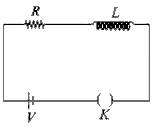The magnetic flux through a circuit of resistance R changes by an amount Δϕ in a time Δt. Then the total quantity of electric charge Q that passes any point in the circuit during the time Δt is represented by
Q=1RΔϕΔt
Q=ΔϕR
Q=ΔϕΔt
Q=R.ΔϕΔt
The correct Answer is:B
To solve the problem, we need to determine the total quantity of electric charge Q that passes through any point in the circuit during the time interval Δt, given that the magnetic flux ΔΦ through the circuit changes in that time.
1. Understanding Faraday's Law of Electromagnetic Induction:
According to Faraday's law, the induced electromotive force (EMF) E in a circuit is equal to the negative rate of change of magnetic flux through the circuit:
E=−dΦdt
In terms of the magnitude, we can express this as:
E=ΔΦΔt
2. Applying Ohm's Law:
The current I in the circuit can be calculated using Ohm's Law, which states that the current is equal to the EMF divided by the resistance R:
I=ER
Substituting the expression for EMF:
I=ΔΦ/ΔtR=ΔΦRΔt
3. Relating Current to Charge:
The current I is also defined as the rate of flow of charge Q over time Δt:
I=dQdt
To find the total charge Q that flows during the time interval Δt, we can rearrange this equation:
Q=I⋅Δt
4. Substituting for Current:
Now, substituting the expression for current I into the equation for charge:
Q=(ΔΦRΔt)⋅Δt
The Δt in the numerator and denominator cancels out:
Q=ΔΦR
5. Final Result:
Thus, the total quantity of electric charge Q that passes through any point in the circuit during the time Δt is given by:
Q=ΔΦR
Summary:
The final expression for the total charge Q is:
Q=ΔΦR
According to Faraday's law, the induced electromotive force (EMF) E in a circuit is equal to the negative rate of change of magnetic flux through the circuit:
E=−dΦdt
In terms of the magnitude, we can express this as:
E=ΔΦΔt
The current I in the circuit can be calculated using Ohm's Law, which states that the current is equal to the EMF divided by the resistance R:
I=ER
Substituting the expression for EMF:
I=ΔΦ/ΔtR=ΔΦRΔt
The current I is also defined as the rate of flow of charge Q over time Δt:
I=dQdt
To find the total charge Q that flows during the time interval Δt, we can rearrange this equation:
Q=I⋅Δt
Now, substituting the expression for current I into the equation for charge:
Q=(ΔΦRΔt)⋅Δt
The Δt in the numerator and denominator cancels out:
Q=ΔΦR
Thus, the total quantity of electric charge Q that passes through any point in the circuit during the time Δt is given by:
Q=ΔΦR
The final expression for the total charge Q is:
Q=ΔΦR
Topper's Solved these Questions
- ELECTROMAGNETIC INDUCTIONBook:AAKASH INSTITUTEChapter:ELECTROMAGNETIC INDUCTIONExercise:ASSIGNMENT(SECTION -D) Assertion-Reason type Question)
Explore 15 Videos
- ELECTROMAGNETIC INDUCTIONBook:AAKASH INSTITUTEChapter:ELECTROMAGNETIC INDUCTIONExercise:ASSIGNMENT(SECTION - B) (OBJECTIVE TYPE QUESTIONS)
Explore 11 Videos
- ELECTRIC CHARGES AND FIELDS Book:AAKASH INSTITUTEChapter:ELECTRIC CHARGES AND FIELDS Exercise:SECTION -J(Aakash Challengers Questions)
Explore 5 Videos
- ELECTROMAGNETIC WAVESBook:AAKASH INSTITUTEChapter:ELECTROMAGNETIC WAVESExercise:ASSIGNMENT SECTION - D Assertion-Reason Type Questions
Explore 25 Videos
Similar Questions
Knowledge Check
The magnetic flux through a circuit of resistance R changes by an amount Δϕ in a time Δt. Then the total quantity of electric charge Q that passes any point in the circuit during the time Δt is represent by
AQ=1r.ΔϕΔtBQ=ΔϕRCQ=ΔϕΔtDQ=(R).ΔϕΔtThe magnetic flux through a circuit of resistance R changes by an amount Adg in time At. The total quantity of electric charge Q, which is passing during this time through any point of the circuit is given by
AQ=ΔϕBΔtBQ=ΔϕBΔt.RCQ=−(ΔϕB))Δt.1RDQ=−ΔϕBRA magnetic flux through a stationary loop with a resistance R varies during the time interval τ as ϕ=at(τ−t). Find the amount of the generated in the loop during that time
Aaτ22RBa2τ23RC2a2τ33RDaτ3R
A magentic flux through a statinary loop with a resistance R varies during the tiem interval τ as Φ=at(τ−t). Find the amount of heat generated in the loop during that time. The inductance of the loop is to be neglected.
View SolutionThe charge q in the circuit shown here varies with time t as :

View SolutionThe charge q in the circuit shown here varies with time t as :

View SolutionThe magnetic flux through a stationary loop with resistance R varies during interval of time T as ϕ = at (T – t). The heat generated during this time neglecting the inductance of loop will be
View SolutionThe charge flowing through a resistance R varies with time tasQ=at−bt2. The total heat produced in R is
View Solution
